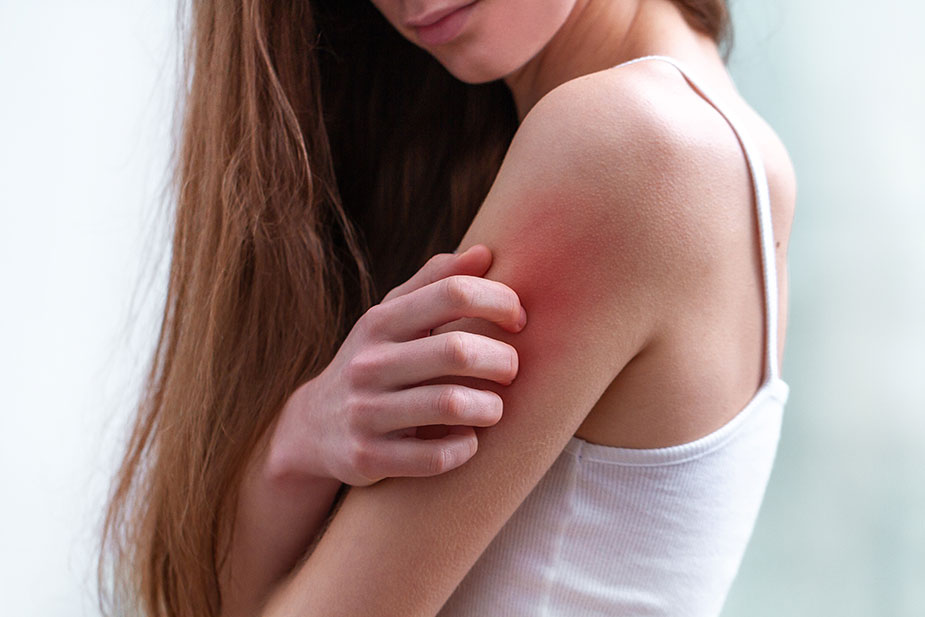Unraveling the Mystery of Histamine and Histamine Intolerance: Ever wondered why you suddenly feel headaches, anxiety, or face an irregular menstrual cycle without any clear cause? Or perhaps you’ve noticed your cheeks turning red after a glass of red wine or an itchy tongue and a runny nose when indulging in bananas, avocado, or eggplant?
If you can relate to these scenarios, it’s time to delve into the fascinating world of histamine intolerance – an enigmatic condition that might just be the answer to your unexplained symptoms. Join us as we uncover the truth behind this often-overlooked sensitivity to histamine and learn how to regain control over your well-being.
What is histamine?
Histamine is a chemical that is part of the immune system, digestive system, and central nervous system. As a neurotransmitter, it transmits important messages from the body to the brain. It is also a component of stomach acid, which helps digest food in the stomach.
You should be well acquainted with histamine since it is associated with the immune system. If you’ve had seasonal allergies or food allergies, you’ve probably noticed that consuming antihistamines provided quick relief of allergy symptoms. That’s because histamine’s role in the body is to trigger an urgent inflammatory (inflammatory) response. Histamine is like a red warning flag for your immune system, informing your body about potential attackers.
Histamine causes swelling and dilation of blood vessels so that white blood cells can quickly find and attack an infection or problem threatening the body. Elevated histamine levels cause headaches, itching, or make you feel exhausted and miserable This is part of your natural immune response, and if you don’t reduce histamine levels properly, you can develop what is called histamine intolerance.
Since histamine circulates in the bloodstream, it can affect your intestines, lungs, skin, brain, and the entire cardiovascular system, contributing to a wide range of symptoms that often complicate precise diagnosis.
Common symptoms of histamine intolerance
- Headaches/migraines
- Sleep problems, easy excitability
- Hypertension Dizziness or fainting
- Arrhythmia or rapid pulse
- Problems regulating body temperature
- Anxiety
- Nausea, vomiting
- Abdominal cramps
- Exhaustion
- Nasal congestion, sneezing, difficulty breathing
- Irregular menstrual cycle
- Swelling in the body
What causes high histamine levels?
Allergies SIBO (Small Intestinal Bacterial Overgrowth)
- Leaky gut
- Gastrointestinal bleeding
- Fermented alcohol such as wine, champagne, and beer
- Deficiency of the enzyme diamine oxidase
- Histamine-rich food
In addition to the histamine produced in your body, various types of food are naturally rich in histamine and cause an increase in histamine levels in the body or block the enzyme diamine oxidase, which breaks down histamine.
Histamine-rich food
Fermented alcoholic beverages, especially wine, champagne, and beer.
Fermented food:
- sauerkraut
- vinegar
- soy sauce
- kefir
- yogurt
- kombucha, etc.
Foods containing vinegar:
- pickles
- mayonnaise
- olives
Processed meats:
- bacon
- salami
- sausages
- smoked meat
- hot dogs, etc.
Sour foods:
- sour milk
- sour cream
- yeast bread, etc.
- Most citrus fruits
- Aged cheeses, including goat cheese
Nuts:
- walnuts
- cashews
- peanuts
Vegetables:
- eggplant
- spinach
- tomato
- avocado
Smoked fish and certain types of fish:
- tuna
- mackerel
- sardines
- herring
Histamine-releasing food:
- Alcohol
- Bananas
- Chocolate
- Cow’s milk
- Nuts
- Papaya
- Pineapple
- Oysters
- Strawberries
- Tomatoes
- Wheat germ
Numerous artificial preservatives and dyes found in processed foods can also trigger histamine release.
A three-day diet plan for histamine intolerance
Day 1:
Breakfast:
- Gluten-free oatmeal with blueberries and chia seeds
- Herbal tea (such as chamomile or rooibos)
Lunch:
- Grilled chicken breast with a mixed green salad (lettuce, cucumber, and carrot) and an olive oil and lemon dressing
- Steamed white rice
Snack:
- Fresh apple slices with almond butter
Dinner:
- Baked salmon with roasted sweet potatoes and steamed green beans
- Freshly squeezed lemonade (made without added sugar)
Day 2:
Breakfast:
- Rice cakes with sunflower seed butter and raspberry jam (low in histamine)
- Green smoothie (spinach, kale, green apple, and coconut water)
Lunch:
- Turkey and avocado lettuce wraps with a side of quinoa salad
- A glass of coconut water
Snack:
- Carrot and celery sticks with hummus (made without garlic or vinegar)
Dinner:
- Roasted chicken thighs with mashed cauliflower and sautéed zucchini
- Herbal tea (such as mint or ginger)
Day 3:
Breakfast:
- Gluten-free toast with scrambled eggs and a side of fresh pineapple
- A glass of rice milk
Lunch:
- Brown rice pasta with homemade tomato-free pesto sauce (basil, pine nuts, olive oil, and nutritional yeast)
- Steamed broccoli
Snack:
- A handful of pumpkin seeds and dried cranberries (low in histamine)
Dinner:
- Pan-seared pork tenderloin with a side of wild rice and roasted Brussels sprouts
- Freshly brewed iced tea (decaffeinated and unsweetened)
Please note that individual tolerance to various foods may vary. Be sure to consult your healthcare provider or a nutritionist to create a personalized meal plan that suits your needs and addresses your histamine intolerance.
How to overcome histamine intolerance
- Follow a low-histamine diet: Start by eliminating or reducing histamine-rich and histamine-releasing foods from your diet. This might provide relief from your symptoms. Keep a food diary to track your food intake and symptoms, which can help identify problematic foods.
- Support your gut health: Ensuring a healthy gut can help alleviate histamine intolerance, as an unhealthy gut is often a contributing factor. Incorporate probiotics, prebiotics, and gut-healing foods like bone broth into your diet.
- Boost your diamine oxidase levels: Certain nutrients can help increase the production of the enzyme diamine oxidase, which breaks down histamine. These include vitamin B6, vitamin C, zinc, and copper. Consult your healthcare provider before starting any supplementation.
- Manage stress: Stress can exacerbate histamine intolerance, so it’s essential to find healthy ways to cope with stress. Incorporate practices like meditation, yoga, and deep breathing exercises into your daily routine.
- Choose fresh food: Opt for fresh, unprocessed foods whenever possible, as they tend to be lower in histamine compared to processed, aged, or fermented foods.
- Use natural antihistamines: Quercetin, stinging nettle, and butterbur are examples of natural antihistamines that can help reduce histamine levels. Consult your healthcare provider before using any of these supplements, as they may interact with medications or cause side effects.
- Test for allergies: Allergies can increase histamine levels in the body, so it’s essential to identify and manage any allergies that you may have. Speak with your healthcare provider about allergy testing options.
- Get professional guidance: Work with a healthcare provider or a nutritionist to create a personalized plan to address your histamine intolerance, as each person’s needs and triggers may vary.
Frequently Asked Questions About Histamine Intolerance
What are the symptoms of histamine intolerance?
Answer: Symptoms of histamine intolerance can vary among individuals and may include headaches, migraines, sleep problems, anxiety, hypertension, dizziness, fainting, arrhythmia, difficulty regulating body temperature, nausea, vomiting, abdominal cramps, exhaustion, nasal congestion, sneezing, difficulty breathing, irregular menstrual cycles, and swelling on the body.
How do you fix histamine intolerance?
Answer: To manage histamine intolerance, follow a low-histamine diet, eliminate or reduce histamine-rich and histamine-releasing foods, support your gut health with probiotics and prebiotics, boost your diamine oxidase enzyme levels with essential nutrients, manage stress through relaxation techniques, choose fresh and unprocessed foods, use natural antihistamines, test for allergies, and work with a healthcare professional or nutritionist to create a personalized plan.
Which foods are high in histamine?
Answer: Foods high in histamine include fermented alcoholic beverages (wine, champagne, beer), fermented foods (sauerkraut, vinegar, soy sauce, kefir, yogurt, kombucha), foods containing vinegar (pickles, mayonnaise, olives), processed meats (bacon, salami, sausages, smoked meat, hot dogs), sour foods (sour milk, sour cream, yeast bread), most citrus fruits, aged cheeses, nuts (walnuts, cashews, peanuts), and certain vegetables (eggplant, spinach, tomato, avocado).
What is the main cause of histamine intolerance?
Answer: Histamine intolerance is primarily caused by an imbalance between the amount of histamine in the body and the capacity to break it down. This can be due to an enzyme deficiency, particularly diamine oxidase (DAO), which is responsible for breaking down histamine. Other factors contributing to histamine intolerance include allergies, gastrointestinal disorders (such as leaky gut and SIBO), consumption of histamine-rich foods, and certain medical conditions.
Conclusion
In conclusion, histamine intolerance is a complex condition that can manifest through various symptoms. By following a low-histamine diet, supporting gut health, and working with a healthcare provider to address underlying issues, you can effectively manage and overcome histamine intolerance, leading to improved overall health and well-being.
It is crucial to maintain open communication with your healthcare professionals to monitor your condition and progress, ensuring that your individual needs are met and adjustments are made when necessary




